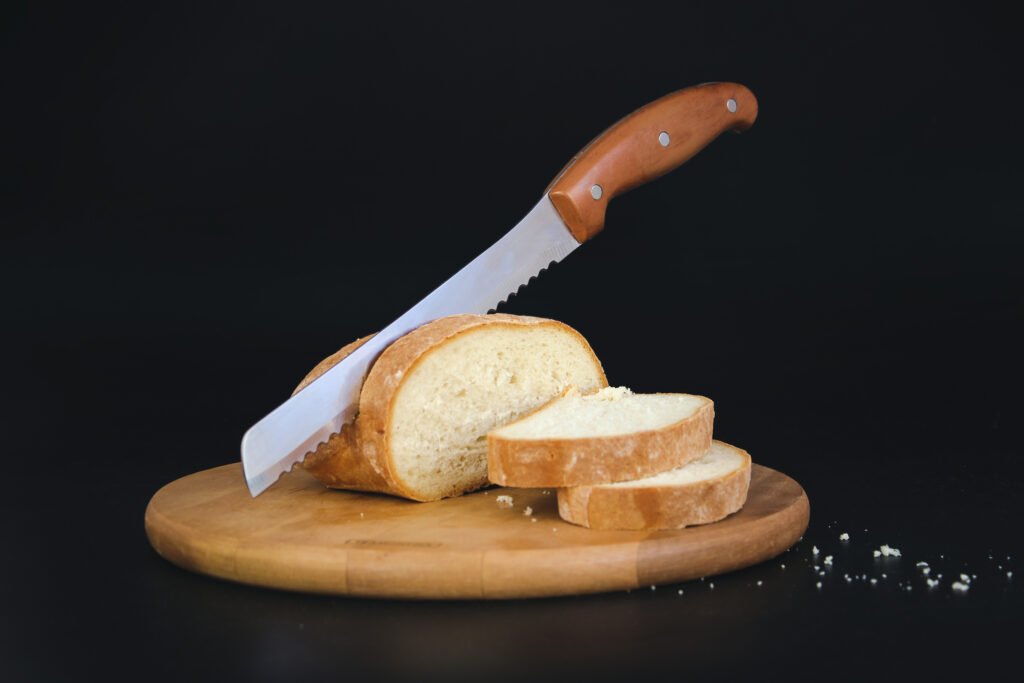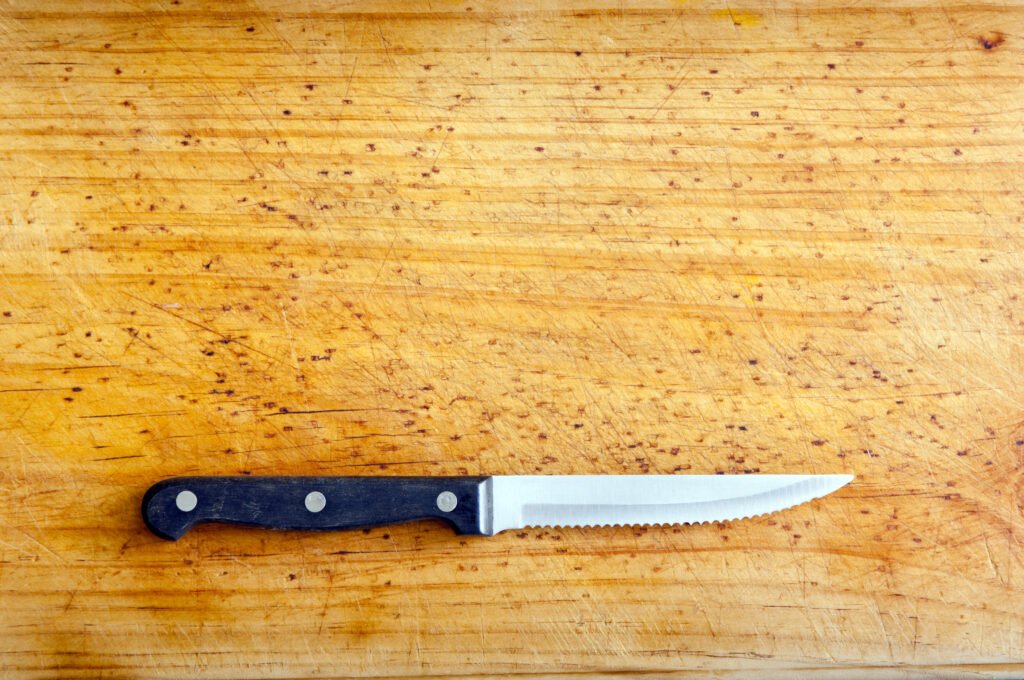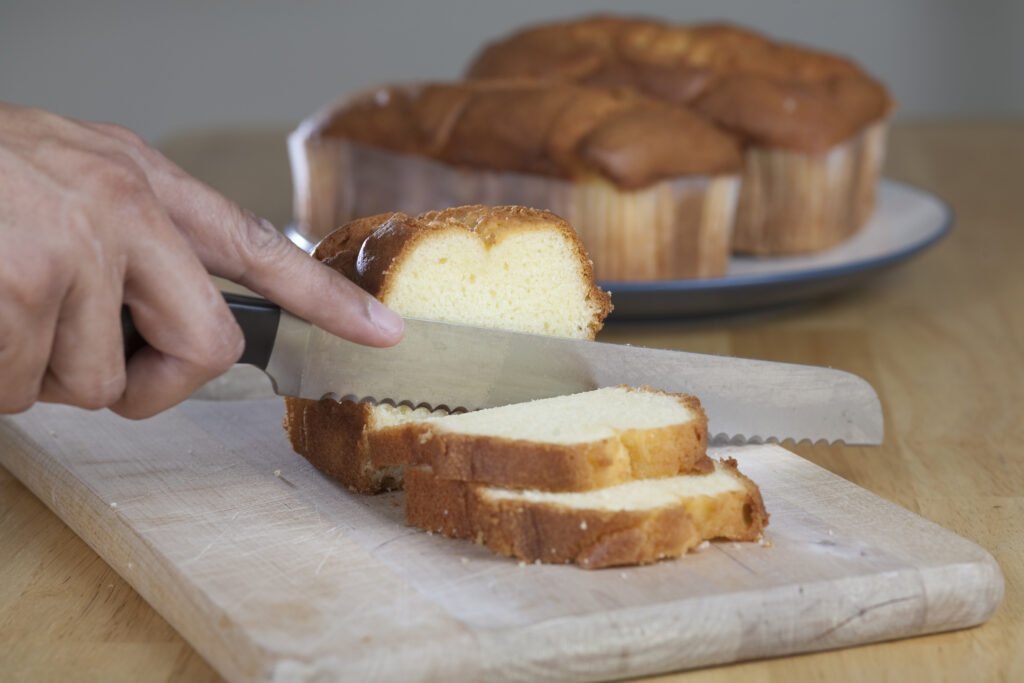Vegan Globetrotter is supported by our audience. When you purchase through one of our links, we may earn a small affiliate commission. As an Amazon Associate I earn from qualifying purchases. Your cost is not affected.
==================
Serrated knives, including the function of serrated knife, have been a staple in many kitchens for a long time. There is still a need to learn more about their purpose and applications. Most people assume that a serrated knife is only helpful for cutting bread. This article will dive into serrated knives and the types available. We will also discuss their pros and cons and the different things you can do with serrated blades besides cutting bread.
What is a Serrated Knife?
A sharp serrated knife, designed for serrated knife usage, is a cutting tool with a blade with small, jagged teeth along the edge. With these serrations, the knife, especially straight serrated edge knife, can grab and cut through rigid surfaces. With this sawing motion, cutting through foods that would be hard to cut with a straight-edged blade is easier. The purpose of serrated knifes extends beyond traditional slicing; they are particularly effective in cutting through bread and fruits with tough skins or rinds. Additionally, these knives are versatile tools for general kitchen tasks, including slicing vegetables and herbs. Understanding the serrated knife uses can enhance their utility in the kitchen, making them essential tools for anyone involved in food preparation.

One of the best things about using a knife with serrations is that it can cut through tough and fibrous foods without breaking or tearing them. This feature is critical when slicing bread since a straight-edged blade can squash or compress the loaf. It often leaves you with an uneven and unattractive slice. With a serrated knife, you can cut bread into perfectly even pieces without making a mess or a fuss.
Another benefit of knives with serrations is that they can do many things. Even though they are often used to cut bread and other baked goods, they can do much more in the kitchen. For this reason, many cooks love them. For instance, the blade’s sharp teeth make cutting through soft fruits like tomatoes and ripe peaches easy. Hence, you can slice food without hurting their flesh.

Serrated knives with a plain edge are a must-have in any kitchen because they are reliable and versatile, allowing people to use them for many different tasks. They even appeal to busy folks, as they can cut through tough foods precisely without damaging them, making food preparation and eating enjoyable altogether.
Different Types of Serrated Knives
You should be familiar with these categories of serrated knives:
? Bread Knife
It would help to have a bread knife to cut through crusty bread without breaking or crushing it. It has a long, narrow blade with deep serrations. Because of the blade’s length, you may take longer, more deliberate cuts. Hence, using it yields more precise and uniform slices.
? Tomato Knife
Since its serrations are shallower than a bread knife, this serrated knife is excellent for cutting soft fruits and vegetables. It cuts flesh clean with its razor-sharp teeth.
? Utility Knife
The serrated utility knife, smaller and more versatile than a bread or steak knife, is ideal for many kitchen tasks. It can slice meat, cheese, fruits, and bread for sandwiches.
? Steak Knife
Manufacturers designed serrated steak knives to cut through the meat, unlike bread knives. They have shorter blades and fewer serrations because of this. The pointed tips make quick work of cooked meat, slicing through it without ripping or destroying it.
Serrated Knives are Used for Benefits but have Drawbacks.
Due to their distinctive design, serrated knives are kitchen knives many people appreciate using. They grasp and cut difficult items like bread and meat with their tiny, jagged teeth on the blade. Therefore, using these blades allows people to divide meals, making them ideal for tasks such as cutting through crusty bread or slicing through tender meats with less effort. If you’ve ever wondered, “What are serrated knives used for?” – their unique serrations make them particularly effective for tackling foods with tough exteriors or delicate interiors.
These kitchen tools’ adaptability is another benefit, especially when it comes to a chef’s knife. They are able to cut sizable portions of meat and thin tomato slices without crushing them. As a consequence, both home cooks and professional chefs value them. They are still fantastic all-purpose knives to have on board because of these features.

However, there are a few drawbacks to using serrated blades. They have flaws, too, like everything else. Their difficulty in sharpening is one drawback. Unlike weapons with a straight edge, serrated knives cannot be sharpened with a stone or steel. As a result, some customers hesitate before purchasing them.
Due to their design, serrated knives are also inappropriate for several tasks. It implies they appear trustworthy but have flaws. They might not peel fruit or slice veggies as well as other knives. Only experts may be able to utilize them effectively.
Serrated kitchen blades thus have advantages and disadvantages. But what makes them renowned is their adaptability and capacity to cut rigid materials. Sadly, they require some care about tools. They may only be useful for specific kitchen chores and require frequent sharpening.
Do You Need One? Yes!
Serrated knives are an essential tool in any kitchen. There are several reasons why you need one in your kitchen. Here are a few:

? They Make Cutting Through Bread a Breeze
As mentioned before, one of its primary uses is cutting through crusty bread. Knives with serrated edges and bread blades are ideal for this. The knife’s serrated edge lets you see through the crust without crushing the soft interior. It makes it easier to get clean, even slices.
? They’re Great for Cutting Through Tough Skins and Rinds
It is also great for cutting through tough skins and rinds on fruits and vegetables. The knife’s saw-like edge lets you see without damaging the delicate flesh.
? They’re Perfect for Slicing Through Tomatoes
Tomatoes can be tricky to slice with a straight-edged knife. Its skin is tough, and its flesh is soft. A serrated knife is perfect for slicing. Through it, tomatoes without crushing the delicate flesh.
? They’re Ideal for Slicing Through Meats
It is also great for slicing through meats with tough fibers or gristle, such as roast beef or pork. The knife’s serrated edge allows you to see through the meat more. It results in cleaner, more even slices.
? They’re Versatile
People can use this serrated blade for other kitchen-cutting tasks. After all, it does well when slicing through cakes. It even cuts through delicate pastries and carves hard cheeses. Thus, seeing this in restaurants and pastry shops isn’t surprising.
What to Look for in a Serrated Knife? Consider these tips!
Now that you know why you need a serrated knife, it’s important to know what to look for when shopping for one. Here are a few things to keep in mind:

? Blade Length
The length of the blade is an important consideration when choosing a knife. Longer blades are better for cutting through larger loaves of bread. Shorter blades are more suited for smaller tasks.
? Serration Depth
The depth of the serrations on the blade is also an important consideration. Deeper serrations are better for cutting through tough materials like crusty bread. Shallower serrations are better for slicing delicate foods like tomatoes or soft cheeses.
? Blade Material
High-carbon stainless steel is popular because it is durable and rust-resistant. It also holds an edge well. Ceramic blades are also becoming popular. They are lightweight, durable, and hold an edge well.
? Handle Comfort
The handle’s Comfort is also important when choosing a knife. Look for a knife with a comfortable, ergonomic handle that is easy to grip and won’t slip out of your hand.
? Price
Finally, Price is also a consideration when choosing a knife. While finding good quality at a reasonable price is possible. Investing in a knife that will last and perform well over time is important. Feel free to spend a little more to get a high-quality knife. Ensuring you make your time in the kitchen more enjoyable and efficient.
Serrated Knives are Used for Many Things
? Cutting Bread
One of the most popular uses of this blade is cutting through crusty bread. It is well-suited for this task because of its saw-like edge. It allows them to slice without squishing or tearing the soft interior. Bread knives are serrated knives designed for this purpose, with longer, narrower blades and deeper serrations than other serrated knives.
? Cutting Through Tough Meats
It is also useful for cutting through meats with tough fibers or gristle, such as roast beef or pork. The saw-like edge of it allows it to see through these materials. It is more easily than a straight-edged knife, making it a valuable tool for any cook.
? Slicing Tomatoes
Tomatoes can be difficult to slice with a straight-edged knife. As the skin is tough and the flesh is delicate. It is well-suited for this task. The saw-like edge allows them to cut through the tough skin without crushing the soft flesh.
? Cutting Through Soft Foods
This blade is also useful for cutting through soft foods. It might otherwise be difficult to slice, such as cakes or ripe avocados. The saw-like edge of it allows it to cut through these materials without squishing or tearing them.
Consider Serrated Knives Used for Food Preparation
The serrations on the blade allow the knife to grip and see through the food. It creates a clean cut without crushing or tearing the delicate interior. It is also useful for cutting through tough cuts of meat and slicing through fibrous vegetables like celery or fennel. These are versatile tools in the kitchen that can be used for various cutting tasks.
Learn more about kitchen tools and equipment for vegan kitchens.
Read More
Frequently Asked Questions
Is a Serrated Knife a Bread Knife?
A bread knife is a serrated knife designed to cut through crusty bread without crushing the soft interior. While all bread knives are serrated knives, not all serrated knives are bread knives. Bread knives have longer, narrower blades than other serrated knives.
What are some other types of serrated knives besides bread knives?
Some other types of serrated knives include utility knives, steak knives, and tomato knives.
Can serrated knives be sharpened?
Sharpening serrated blades requires a different method than sharpening straight-edged knives. Special sharpeners are available that can sharpen the serrations without damaging the blade.
How should I care for my serrated knife?
It should be hand-washed and dried immediately after use. Avoid putting them in the dishwasher, as the high heat and harsh detergents can damage the blade. Store them in a knife block or a protective sheath to prevent damage to the blade.
Serrated blades cost more than straight-edged knives?
Serrated knives are more expensive than straight-edged knives. It depends on the quality of the knife and the materials used to make it. Some inexpensive serrated knives are available but may not be as durable or effective as higher-quality models.
Can you do anything with a serrated knife besides cut food?
Other uses for it include trimming fabric and cutting through packaging. Yet, it is important to remember that using it for non-food tasks can dull the blade more than using it only for food.



Don't miss out
when new recipes and information are added!
Join our newsletter for free recipes,
healthy living inspiration, and special offers
You have Successfully Subscribed!